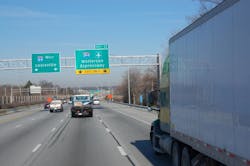The recent settlement deal between the International Brotherhood of Teamsters and port trucking form Pacific 9 Transportation is getting a lot of attention in the news today, mainly about whether this deal more fully opens the door to union organization efforts among port drivers in Los Angeles and Long Beach; an issue many of those involved hope will lead to wage increases for said drivers.
A more relevant question, though, is how this particular deal – whatever the short-term implications – affects the truck driver landscape as a whole. From that perspective, on balance, I think it won’t do much because there are far larger issues at play than whether port drivers get to organize in a union or not and whether they get significant pay increases or not.
The heart of the issue is this: driving a truck for a living is not only something fewer and fewer people want to do, it’s being actively discouraged as a profession even among those within the industry itself.Phil Byrd (at right) – president and CEO of Bulldog Hiway Express and current chairman of the American Trucking Associations trade group – addressed this topic a few weeks back during the keynote speech at the 2014 Technology & Maintenance Council (TMC) annual meeting.
“How many of you here would want your sons and daughters or nieces and nephews to become truck drivers and technicians?” he asked of the several hundred TMC attendees in the audience. “I see a couple of hands raised and I applaud you. But I say to you all, ladies and gentlemen, that this is a problem for our industry.”
The “problem” of course isn’t easily solved, for if fleet executives and managers won’t recommend the two most vital trucking jobs to their families, how can they go out and honestly – as well as passionately – recruit others to do the work?
Paul Newbourne, senior VP-operations for Pittsburgh-based Armada Supply Chain Solutions, touched on this very same “problem” too in a recent conference call with reporters hosted by Wall Street investment firm Stifel Nicolaus & Co.
“I doubt anyone on this call is encouraging their children, grandchildren, nieces, nephews, or other relatives to be truck drivers,” he said matter-of-factly.
“The biggest issues to finding and keeping drivers remain compensation rates and the lifestyle,” Newbourne noted. “But every carrier I’ve spoken with also highlights he often unprofessional treatment of their drivers by shipper and receiver personnel: the rude treatment, the lack of access to bathrooms and vending machines for food at the dock. They restrict truck engine idle time but make no other provisions available for drivers to keep warm or stay cool – especially in extreme weather.”
He told me on the call that Armada is trying to “lead by example” to address such issues where its own warehouses and terminals are concerned.
“We’ve put together a ‘facilities attribute list’ so when we build a new location we include such amenities as a driver’s lounge as well as safe truck parking space for rest breaks or overnight stays,” Newbourne said. “We’ve also found that more collaboration between carriers and shippers can alleviate a lot of issues as well.”In particular, he noted that “wait time” at decks remains a huge issue for both carriers and truck drivers alike as it reduces asset utilization for the trucking company as well as reduces pay for drivers. In some cases Newbourne noted that efforts on the part of shippers and receivers to reduce and eliminate wait time – often via moving to “drop and hook” style operations – can actually reduce their freight costs overall as in many instances carriers forgo rate increases if it translates into more availability for their drivers and equipment to haul revenue-producing loads.
“Carriers don’t want detention fees; they want their drivers rolling up and down the road hauling freight … and that’s what the drivers want as well,” he explained. “Collaboration that drives efficiencies for carriers, shippers and receivers alike – that delivers economic benefit to everyone – is what can solve many problems.”
By extension, then, if such “collaborative” efforts are focused on making the life – and the pay – of the truck driver better, while providing economic benefit to their employers and customers alike, perhaps the ongoing shortage of truck drivers could be lessened, along with the bitter wrangling over low pay and work conditions as well.
It’s not a “silver bullet” suggestion by any means, nor is this something that can be done overnight. But the shortage of drivers added to the unwillingness of folks to enter the profession needs to be solved … and the industry is running out of time to find solutions.





